St Joseph's Orphanage and Hospital for the Sick Poor, Preston, Lancashire
St Joseph's Orphanage for Roman Catholic Girls, in Preston, Lancashire, was officially opened on September 19th, 1872. The establishment, located at the south end of Theatre Street, owed its existence to a gift of £10,000 by Mrs Maria Holland, a resident of the town. Around £6,000 was used to construct the building, and £4,000 to endow up to 30 places, with preference being given to Prestonians
The premises were described in a report at the time as follows:
The building is gothic, and forms in plan the letter H. It is constructed of bricks with stone dressings, the roof being covered with Broomhalls and Co.'s light and dull red tiles, and the pinnacles, &c., ornamented with metal gothic crosses. This variety of colour and material gives to the exterior a pleasing and picturesque appearance. The principal entrance is approached through Theatre- street, from whence an imperfect view only can be obtained of the building. This entrance is surmounted by a small tower, from which a bell will toll the Angelus, and give the signal for the ordinary every day duties of the Orphanage. Immediately above the door is inscribed the name of the donor, and the occasion of the gift, which inscription runs as follows:—"St. Joseph's Orphanage, erected Anno Domini 1872, endowed by Mrs. Maria Holland, Preston." There is another entrance to the front, which may be termed "the tradesman's entrance," or for those who have business with the house. Passing to the back, a good view of the whole structure may ha obtained from the direction of the station, or indeed from any part of the neighbouring country. On this or the north-east portion of the house a beautiful statue representing St. Joseph, designed by Mr. Hughes, architect, and executed by Mr. Miles, sculptor, stands out to view, in a niche prepared for it, and indicates that there is apportioned off the chapel where the devotional services of the community are to be performed. A large and open playground is here contrived for the orphans, whilst a portion of it is reserved for the recreation of the nuns. It is suggested that should the entrance from Theatre-street prove insufficient another will be opened out of Mount-street, as a few houses situated there are the property of the Orphanage.
The interior of the building is admirably adapted to the purpose for which it is intended. It is divided into three distinct portions—the visitors, nuns, and children's quarters. As you go in are the visitors' rooms, shut off from the rest of the house. Then comes the convent portion consisting of a spacious gallery into which the private rooms of the nuns open. Then comes the business room of the Superioress, the recreation room, airy and light, then the refectory, affording accommodation for at least 10 nuns, and afterwards the general, workroom for the same. To the north in one uninterrupted range come the kitchen—fitted up with the latest cooking apparatus—store room, scullery, larder, and dairy. A vestible door is opened in the middle of the gallery, and we are admitted into the children's quarters, where every attention has been paid to secure comfort and health to the inmates. They have—when it is so disposed to shine—the advantage of the sun all day. There is a large refectory, and near to this a school for the orphans. The infirmary is to the south so that in case of infection there is no possibility of the disease spreading in the house as the ventilation is contrary. Above—a remarkable feature in the interior—is a splendid and especially ventilated dormitory with accommodation for over 30 children, single bedded, with good iron bedsteads and bedding, and bell for sounding the rising. At the head of the room is a small apartment, which commands a view of the whole dormitory, and is intended for the "watch " during the night. On the other side of the gallery is a lavatory fitted with baths, &c., where the inmates will make their daily ablutions. On the south-west portion is the domestic chapel, the work of which has been assigned to Messrs. Park and Co.; a beautiful picture, the production of a Roman artist, and representing St. Joseph at work with the infant Jesus, is placed above the altar, and harmonises with the general bearing of the establishment. In the cellar are stores and washing places provided with all necessaries. There is a drying machine which is calculated to dry a blanket in seven minutes, and a splendid bakery, the particular design of Mr. Hughes. Places for washing, shoes, and taking recreation during the inclement whether, are also arranged in the cellar. The contractors for the whole of the work were Messrs. Rigby and Midgall, the sub-contractors being—for brick work Mr. Christian, for masonry Mr. Williamson, for plumbing and glazing Messrs. Westray and Woods, and for plastering Mr. Walker. The architects are Messrs. Pierpoint and Hughes (Preston and Warrington).
The Orphanage was run by the Sisters of Charity of Our Lady Mother of Mercy.
The St Joseph's site is shown on the 1892 map below.
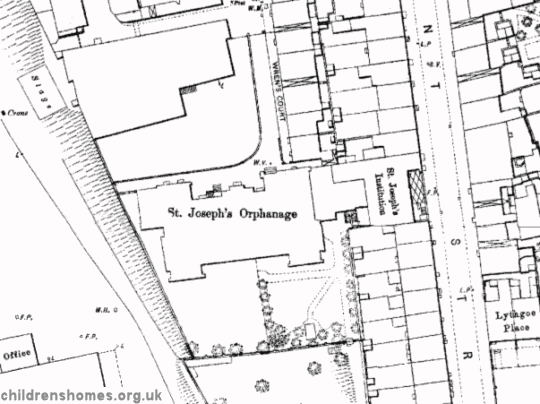
St Joseph's Orphanage site, Preston, c.1892.

St Joseph's Orphanage from the north, Preston, 2013. © Peter Higginbotham

St Joseph's Orphanage from the north, Preston, 2013. © Peter Higginbotham
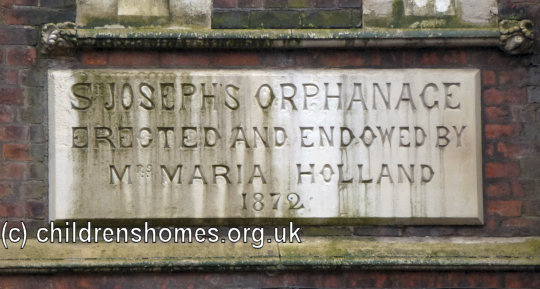
St Joseph's Orphanage, Preston, 2013. © Peter Higginbotham
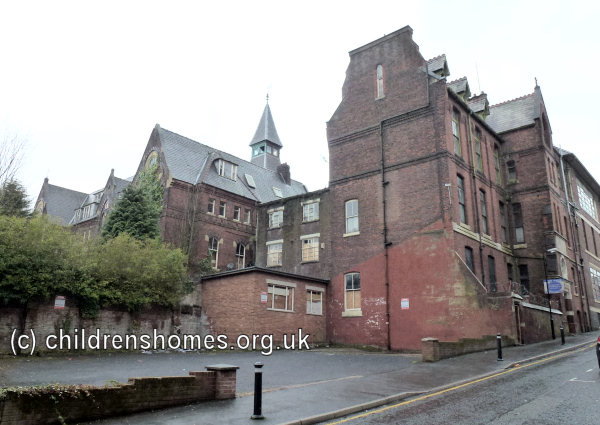
St Joseph's Orphanage from the south-east, Preston, 2013. © Peter Higginbotham
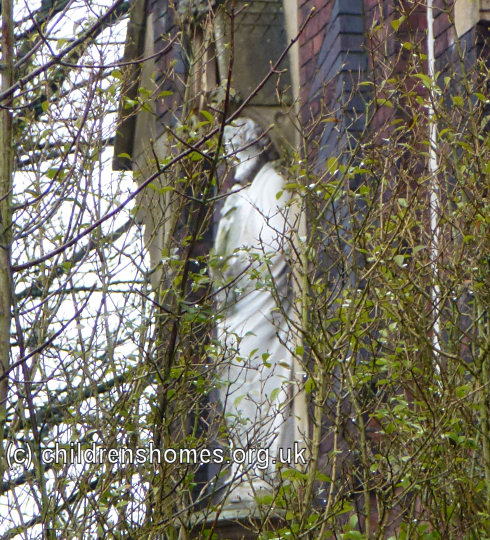
St Joseph's Orphanage, Preston, 2013. © Peter Higginbotham
The Orphanage received and trained orphan and destitute girls from two years old and upwards. Girls generally remained until the age of 14 or 15, some longer. As well as classroom education by a certified schoolmistress, they were taught housework. Some were trained as teachers, while others were placed as servants, shop-girls, machinists, or in other employments for which they showed aptitude. Many went as servants in hospitals.
In 1877, a further gift from Mrs Holland, funded the construction of a hospital for the sick poor. It was located on Mount Street, immediately adjacent to the Orphanage.

St Joseph's Hospital for the Sick Poor from the south-east, Preston, 2013. © Peter Higginbotham
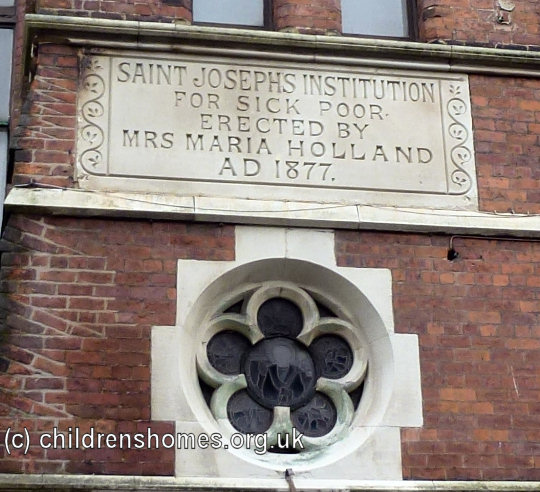
St Joseph's Hospital for the Sick Poor, Preston, 2013. © Peter Higginbotham
On 22nd March 1879, the Orphanage was officially accredited as a Certified School, allowing it to receive girls boarded out by the workhouse authorities. Its certification was cancelled on 17 July 1890.
The whole site subsequently became St Joseph's Hospital, with accommodation for workhouse girls being provided at the new Moorfield Orphanage, which opened in 1905.
During the First World War, St Jospeh's provided care for wounded soldiers including some Belgian troops. From 1958, the site also acted as a training centre for nurses. After the Hospital closed in the late 1980s, the Mount Street Nursing Home operated on the premises.
Records
Note: many repositories impose a closure period of up to 100 years for records identifying individuals. Before travelling a long distance, always check that the records you want to consult will be available.
- Lancashire Record Office, Bow Lane, Preston, Lancashire, PR1 2RE. Has extensive records for the Hospital and a few items relating to the Orphanage.
Census
Bibliography
- Higginbotham, Peter Children's Homes: A History of Institutional Care for Britain s Young (2017, Pen & Sword)
Links
Except where indicated, this page () © Peter Higginbotham. Contents may not be reproduced without permission.


